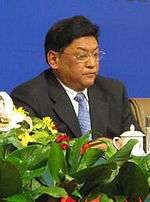Padma Choling
| Padma Choling | |
|---|---|
|
པདྨ་འཕྲིན་ལས་ 白玛赤林 | |
 Padma Choling at the 2010 National People's Congress | |
| President of Tibet Autonomous Region People's Congress Standing Committee | |
|
In office January 2013 – January 2017 | |
| Preceded by | Qiangba Puncog |
| Succeeded by | Losang Jamcan |
| Chairman of Tibet Autonomous Region People's Government | |
|
In office January 2010 – January 2013 | |
| Preceded by | Qiangba Puncog |
| Succeeded by | Losang Jamcan |
| Vice Chairman of Tibet Autonomous Region People's Government | |
|
In office 2003 – January 15, 2010 | |
| Preceded by | Gyamco |
| Succeeded by | Losang Jamcan |
| Personal details | |
| Born |
October 1952 (age 66) Qamdo, Tibet, China |
| Nationality | Chinese |
| Political party | Communist Party of China |
| Alma mater | Central Party School |
| Occupation | Politician |
Padma Choling (Tibetan: པདྨ་འཕྲིན་ལས་, Wylie: padma 'phrin-las, Lhasa dialect IPA: pɛ́mɑ̀ ʈʰĩ́lɪ᷈ː ; alternatively Pema Thinley, Pelma Chiley, Baima Chilin;[1] Chinese: 白玛赤林; pinyin: Báimă Chìlín; born October 1952) is a politician. He was the eighth and Chairman of the Tibet Autonomous Region (TAR), China, but in January 2013, was replaced by his deputy Losang Jamcan.[2][3] Later he served as the Tibet Autonomous Region People's Congress. As Chairman of TAR, Choling was the "most senior ethnic Tibetan in the regional government",[4] though he was subordinate to the TAR Communist Party Chief Zhang Qingli, and later his successor Chen Quanguo.[1]
Biography
Padma Choling was born in 1952 in a farming family in Dêngqên County, Chamdo Prefecture.[5] He joined the People's Liberation Army in Qinghai Province at 17, and served in the army for seventeen years. In the army he played basketball and mastered the Chinese language. He joined the Communist Party of China in October 1970. He was an official in the Tibetan regional government since December 1969,[6] working in Xigaze and then Lhasa, rising to the vice-chairmanship of the TAR in 2003.[5] After his anodyne handling of an earthquake in Damxung County outside Lhasa, he was elected the chairman of the Tibet Autonomous Region in 2010.[7]
Chairmanship
Personally, he has been described as "stern, but... amiable" in contrast to his "soft-spoken" predecessor Qiangba Puncog.[7] In addition to stability and ethnic harmony, he has set a goal of 12 percent GDP growth and a ¥4,000 per capita GDP for farmers and herders in the Tibet Autonomous Region.[8] To bring this about, he has signed an agreement with the Ministry of Commerce of the Central Government to allow it to promote trade with South Asia, including Nepal.[9] Padma is of the opinion that there is no "issue of Tibet" that the Dalai Lama says, and questions the Lama's ability to judge the situation in Tibet since he has not been in Tibet since 1959.[10]
On the issue of religion, Padma has said that he and the Karmapa, Ogyen Trinley Dorje are "mates from the same hometown".[4] At the 2010 National People's Congress, he announced that the choosing of the 15th Dalai Lama would abide by the "requirements of Tibetan Buddhist tradition", including approval by the government, instead of being the choice of the 14th Dalai Lama. Already, he has dismissed the Dalai Lama's choice for the 11th Panchen Lama as "invalid".[11] He has included monks and nuns over the age of 60 into the Chinese state social security, and works with legislation delivering roads, electricity, and water to monasteries.[10]
Moreover, Pema Thinley, said at a Press Conference that Gedun Choki Nyima - the child recognized by the Dalai Lama as the reincarnation of the 10th Panchen Lama - is an ordinary person, and that he and his parents wanted to stay away from public attention for their own safety.[12]
On March 17, 2018, Padma was elected as the Vice Chairperson of the Standing Committee of the National People's Congress.[13]
Padma is a member of the 18th Central Committee of the Communist Party of China.
References
- 1 2 Hornby, Lucy; Huang Yan; Blanchard, Ben (2010-01-15). "China chooses former soldier as new Tibet governor". Reuters. Retrieved 2010-07-30.
- ↑ "China appoints new Tibet governor, hardline policies to remain". Reuters. 2013-01-29. Retrieved 2013-02-15.
- ↑ "New Tibet chairman vows further reform". China Daily. 2013-01-29. Retrieved 2013-02-15.
- 1 2 Liu, Melinda (2010-04-05). "Beijing's Man in Tibet". Newsweek. Retrieved 2010-07-29.
- 1 2 Mirenda (2010-03-14). "Feature: Fruits of development shared by every Tibetan". China Tibet Information Center. Retrieved 2010-07-30.
- ↑ "Qiangba Puncog and Baima Chilin's brief resumes". China Tibet Information Center. 2010-01-15. Archived from the original on 2011-07-07. Retrieved 2010-08-07.
- 1 2 Zhou, Yan (2010-01-15). "Tibet parliament session announces leadership changes". Xinhua. Archived from the original on 2010-01-18. Retrieved 2010-07-29.
- ↑ "Tibet's new governor promises social stability, unity". The Hindu. 2010-01-15. Retrieved 2010-07-29.
- ↑ "MOFCOM and Tibet Signed Agreement of Cooperation in Providing Commercial Development Assistance". MOFCOM. 2010-03-12. Retrieved 2010-07-30.
- 1 2 "Lawmakers lash out at Dalai Lama's speech". People's Daily. Xinhua. 2010-03-11. Retrieved 2010-07-30.
- ↑ Wong, Edward (2010-03-07). "No Leeway Given in Picking Dalai Lama". The New York Times. Retrieved 2010-07-30.
- ↑ Official: Dalai-picked 'Panchen' lives normal life
- ↑ "十三届全国人大一次会议选举产生全国人大常委会副委员长、秘书长". Xinhua. Retrieved 2018-03-17.
| Assembly seats | ||
|---|---|---|
| Preceded by Qiangba Puncog |
President of Tibet Autonomous Region People's Congress Standing Committee January 2013 – January 2017 |
Succeeded by Losang Jamcan |
| Government offices | ||
| Preceded by Qiangba Puncog |
Chairman of Tibet Autonomous Region People's Government January 2010 – January 2013 |
Succeeded by Losang Jamcan |
| Preceded by Gyamco |
Executive Vice Chairman of Tibet Autonomous Region People's Government 2006–2010 |
Succeeded by Losang Jamcan |